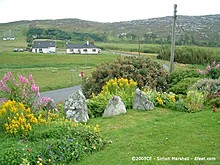|
|
|
|
Coire na FeinneChambered Cairn
|
||||||||||||||||||||||||
|
|
|
Images (click to view fullsize) |
|














|
Fieldnotes |
|
|
We came to this site after a day at the beaches of Luskentyre with its fantastic colour schemes and the reverse walking of the Coffin Road. Normally coffins would come from the east to the west so we walked in the opposite direction to come back via the northern following the old main road, quarries and Laxdale. We spotted no coffins. The best place to park is near the chippy van at the Horgabost Camp Site and walk west up the A859 until its junction with the minor road heading east to the Horgabost township. With the road passing nearby, indeed one of the stones looks like it is trying to escape, the chamber cairn is situated in a garden looking west into the beautiful bay. Only the capstone and six slabs remain in the well tended garden. At least the cairn is being looked after. All the smaller cairn material was removed long before the house was built. After asking permission I was allowed to wander about and have a look. Great wee place, very easy to find. Visited 3/8/2017. |
25th September 2017ce |
|
I have Margaret Curtis to thank for pointing this one out. She joined me and Friend for our trip down to west Harris one windy but bright day a couple of days after we spent an afternoon with her at Callanish. A burial chamber in someone's garden near to Horgabost beach on Harris. Thrilling to see as no way would we have spotted it without Margaret's knowledge and generosity in sharing it. |
 Posted by tjj
Posted by tjj30th May 2013ce Edited 30th May 2013ce |
|
Visited 5th August 2004: This is an interestingly placed site. It's effectively become a garden feature, but it's a well kept garden, and when we visited the owner was very friendly. She was happy for us to take a look at the stones from the garden side of the boundary. If you visit, please ask before entering the garden area or taking photos from inside the garden. It would be a shame to upset the people who look after this site, especially as they are so congenial. Coir Fhinn may not be everyone's cup of tea, but I rather liked it. Well worth taking a look at if you're in the area visiting other sites. |
 Posted by Kammer
Posted by Kammer7th April 2005ce Edited 7th April 2005ce |
|
Quelle horeure! Chambered cairn meets Gardeners' World. Just for the record, what we have here are the W and N stones of a E facing chamber. Of curiosity value only but, depending on where you park, you'll pass it on the way to The MacLeod Stone. Visited 30 July 2004 |
 Posted by greywether
Posted by greywether15th August 2004ce Edited 4th April 2005ce |
Folklore |
|
A tale of strange fairy cows, that usually live (obviously) under the sea. Traigh Niosaboist is the beach immediately near the chambered cairn. Several generations ago a herd of cows came ashore at Nisabost, which then formed part of the farm of Luskentyre, in South Harris. In order to prevent their return to the sea, if possible, the natives got between them and the shore, and drove them inland with the assistance of such weapons as lay ready to hand. It was discovered that even handfuls of sand thrown between these sea-cows and the shore checked their return to the sea. In many respects these particular animals resembled ordinary Highland cattle, although they were known to dwell under the sea, and to feed on the sea-weed called meillich in the Gaelic. Some of them broke back to the sea: others settled down at Luskentyre.From The peat-fire flame by Alasdair Alpin MacGregor (1937). |
 Posted by Rhiannon
Posted by Rhiannon11th December 2013ce Edited 11th December 2013ce |

